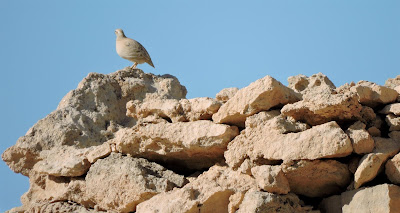A week ago Friday I made the long day trip to Mazyunah on the border with Yemen with visiting birder Markus Craig.
It is sufficiently different from Salalah to give me prospects of new additions to my Oman list. Notably I had Dunn's lark, golden eagle and little crake (at the small wetland there) on my mind. All three are tricky birds. Indeed any bird not already on my country list is tricky. The list is too long now to have any "easy" left.
To get to Mazyunah you have to travel to Thumrait and then via Mudhai. The stretch of road between Thumrait and Mudhai is about the only place in recent years where the elusive Dunn's lark has verifiability been seen (though there have been more doubtful reports from Al Beed farm).
We studied every lark we came across there causing us to "lose"all the early morning. Every one was a desert lark. Dunn's lark is tough.
Desert lark by Markus Craig
As we finally pressed on towards Mazyunah we stopped briefly at a hamlet called Qafa on a dirt side road marked towards Shisr. I had seen European turtle dove and a crowned sandgrouse there on a previous stop.
Black redstart
This time the best bird was a black redstart assumed to on passage as the habitat there is very open. The small water tank is a big attraction.
As we neared Mazyunah we noticed the town's rubbish dump on the left hand side about 5 kilometres out.
Scattered on the hill tops around it were several large birds of prey which all turned out to steppe eagle with one griffon vulture which soon departed.
steppe eagle perched
The steppe eagle were all adult or near adult.
steppe eagle 1
They approached closely on occasion.
steppe eagle 2
We stayed some while as it was always possible that a golden eagle might be around. It proved not to be the case.
Egyptian vulture
Nevertheless by staying we noticed the arrival of six Egyptian vulture.
Spotted sandgrouse
Twenty spotted sandgrouse also flew over.
Close to Mazyunah we divided our time during the day between the old sewage pond just to the north of the city and the smaller new sewage works to the south off the Tosinat (dirt) road.
The latter had few birds except on our first arrival where three birds of prey were drinking. These were two Eastern Imperial Eagle and one steppe eagle.
Eastern Imperial eagle at new sewage works by Markus Craig
The old sewage pond with its reeds and overflow creating a long stream is the best birding location though.
Eastern Imperial eagle at old sewage pond
Here several Eastern Imperial eagle came and went to drink all day long. Ducks and waders included pintail, teal, garganey, mallard, ruff, Temminck's stint, wood sandpiper and more. All these were in a desert location.
Desert wheatear were scattered around but there was also one red-tailed wheatear. It is right at the south westerly edge of its known wintering range.
red-tailed wheatear
From four pm onward birding came frenetic. Bird activity rose substantially. It began as we spotted a wintering whinchat. This follows on from one seen at Muntasar oasis a few weeks ago.
whinchat by Markus Craig
Four water pipit hadn't been seen during the day either.
water pipit by Markus Craig
Both Eurasian collared dove and African collared dove started to gather around the reeds where we assume they roost at night. The numbers that can be seen here are the highest in Oman.
African collared dove (l) and Eurasian collared dove (r)
To finish the day we looked for crakes and found two very quickly. One was a spotted crake which was seen first and was more open.
spotted crake
The second was more problematic. We had trouble with quaity of our photographs and separating the possibilities of adult Baillon's crake from adult male little crake.
We saw the bird had clean deep blue underparts with little barring on the flanks and the shape including primary projection supported little crake. However we struggled to see any red on the bill. This left us in some doubt.
Luckily Hanne and Jens Eriksen visited four days later and cleared the mystery up. From their observations and pictures it can be seen the the red at the base of the bill is very small. This was a lifer for me and instructive in what features can and can't be used in the field to separate the adult male birds.
little crake at Mazyunah by Hanne and Jens Eriksen
Little crake and particularly adult birds are uncommon in Oman. Mazyunah is about as close to their main migration route (a little north and west of Oman) as there is in the country.
close up of little crake at Mazyunah by Hanne and Jens Eriksen
I am grateful for Markus Craig's company on this trip and permission to reproduce some of his photographs. I am equally grateful to Hanne and Jens Eriksen for permission to reproduce their photographs of little crake. Ownership of all these photos remains with them.




























































